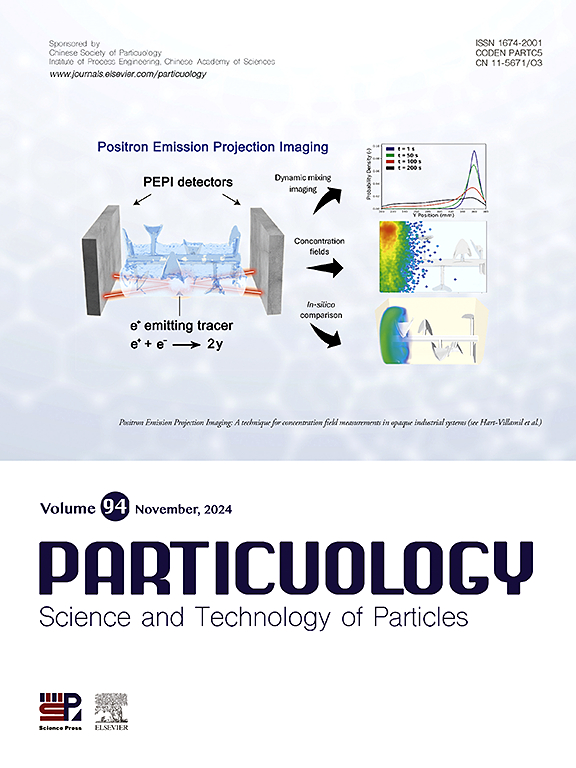Subgrid drag models for simulating circulating turbulent fluidized beds of Geldart A particles
IF 4.3
2区 材料科学
Q2 ENGINEERING, CHEMICAL
引用次数: 0
Abstract
The novel circulating turbulent fluidized bed (CTFB) technology has found wide applications in various processes owing to its high solid circulation rate and low backmixing. However, up to now, only a limited number of CFD simulation studies on this type of reactor can be found in the literature. Moreover, there is currently no guidance available for selecting appropriate subgrid drag models that take into account the impact of mesoscale structures. In this work, a two-fluid model incorporating seven different drag models include homogeneous drag models, filtered models, and EMMS-based drag models was employed to conduct a systematic investigation into the hydrodynamics of CTFB reactors. It was found that the flow structure in the CTFB reactor differs significantly from conventional fast fluidized beds, exhibiting relatively weaker radial heterogeneity and attenuated near-wall particle downward flows. Comparative analysis demonstrates that the homogeneous drag models fail to predict reasonable hydrodynamics consistent with the experiments. In contrast, the mesoscale drag models show satisfactory performance in reproducing solid concentration profiles, while additional marker variables should be considered in the drag models to enhance the prediction accuracy of particle velocity. The EMMS-based drag model with an advanced conservation equation for cluster size achieves better accuracy in predicting both solid concentration and velocity distributions. Nevertheless, future model development should address wall boundary effects to enhance mesoscale drag applicability in CTFB simulations.

模拟Geldart A颗粒循环湍流流化床的亚网格阻力模型
新型循环湍流流化床(CTFB)技术以其高固相循环速率和低返混率在各种工艺中得到了广泛的应用。然而,到目前为止,文献中对该类反应器的CFD模拟研究数量有限。此外,目前还没有指导如何选择适当的考虑中尺度结构影响的子网格拖动模式。在这项工作中,采用两流体模型,包括7种不同的阻力模型,包括均匀阻力模型、过滤模型和基于emms的阻力模型,对CTFB反应器的流体动力学进行了系统的研究。研究发现,CTFB反应器内的流动结构与常规快速流化床有明显不同,径向非均质性相对较弱,近壁颗粒向下流动减弱。对比分析表明,均质阻力模型不能较好地预测与实验相符的水动力。中尺度阻力模型在模拟固体浓度分布方面表现较好,但要提高颗粒速度的预测精度,还需要考虑额外的标记变量。基于emms的阻力模型具有先进的簇大小守恒方程,在预测固体浓度和速度分布方面具有更好的准确性。然而,未来的模式发展应该解决壁面边界效应,以提高CTFB模拟中尺度阻力的适用性。
本文章由计算机程序翻译,如有差异,请以英文原文为准。
求助全文
约1分钟内获得全文
求助全文
来源期刊

Particuology
工程技术-材料科学:综合
CiteScore
6.70
自引率
2.90%
发文量
1730
审稿时长
32 days
期刊介绍:
The word ‘particuology’ was coined to parallel the discipline for the science and technology of particles.
Particuology is an interdisciplinary journal that publishes frontier research articles and critical reviews on the discovery, formulation and engineering of particulate materials, processes and systems. It especially welcomes contributions utilising advanced theoretical, modelling and measurement methods to enable the discovery and creation of new particulate materials, and the manufacturing of functional particulate-based products, such as sensors.
Papers are handled by Thematic Editors who oversee contributions from specific subject fields. These fields are classified into: Particle Synthesis and Modification; Particle Characterization and Measurement; Granular Systems and Bulk Solids Technology; Fluidization and Particle-Fluid Systems; Aerosols; and Applications of Particle Technology.
Key topics concerning the creation and processing of particulates include:
-Modelling and simulation of particle formation, collective behaviour of particles and systems for particle production over a broad spectrum of length scales
-Mining of experimental data for particle synthesis and surface properties to facilitate the creation of new materials and processes
-Particle design and preparation including controlled response and sensing functionalities in formation, delivery systems and biological systems, etc.
-Experimental and computational methods for visualization and analysis of particulate system.
These topics are broadly relevant to the production of materials, pharmaceuticals and food, and to the conversion of energy resources to fuels and protection of the environment.
 求助内容:
求助内容: 应助结果提醒方式:
应助结果提醒方式:


